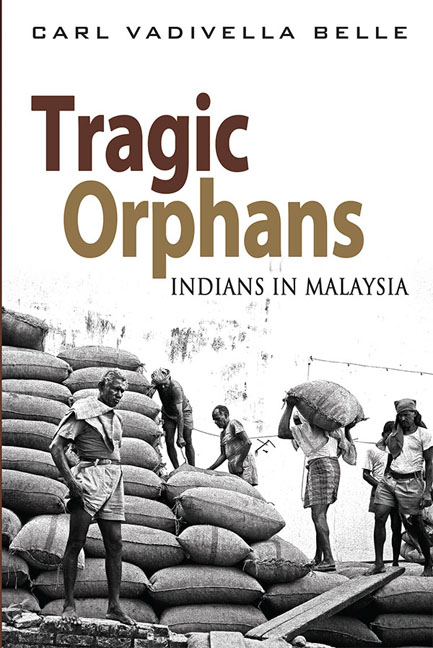Book contents
- Frontmatter
- Contents
- Acknowledgements
- List of Abbreviations
- Introduction
- 1 The Malay Peninsula: Early History, Melaka and the Colonial Setting
- 2 European Colonialism and the Malay Peninsula
- 3 India and the Development of British Ideologies of Empire
- 4 British Governance of Malaya
- 5 Slavery and Indentured Labour
- 6 Indian Indentured Labour in Malaya
- 7 Kangany Labour in Malaya
- 8 Other Indian Immigration
- 9 Indian Political Development to 1941
- 10 The Japanese Invasion, Subhas Chandra Bose and Indian Wartime Nationalism
- 11 The Post–war Period: Reform and Repression: 1945–48
- 12 From Federation to Merdeka
- 13 From Malaya to Malaysia: Singapore, 13 May and the New Economic Policy
- 14 The Mahathir Years: A Changing Malaysian Landscape
- 15 Abdullah Badawi, Islamization, and the Rise of Hindraf
- 16 Najib and 1Malaysia: A New Deal?
- Conclusions
- Bibliography
- Index
1 - The Malay Peninsula: Early History, Melaka and the Colonial Setting
Published online by Cambridge University Press: 06 June 2017
- Frontmatter
- Contents
- Acknowledgements
- List of Abbreviations
- Introduction
- 1 The Malay Peninsula: Early History, Melaka and the Colonial Setting
- 2 European Colonialism and the Malay Peninsula
- 3 India and the Development of British Ideologies of Empire
- 4 British Governance of Malaya
- 5 Slavery and Indentured Labour
- 6 Indian Indentured Labour in Malaya
- 7 Kangany Labour in Malaya
- 8 Other Indian Immigration
- 9 Indian Political Development to 1941
- 10 The Japanese Invasion, Subhas Chandra Bose and Indian Wartime Nationalism
- 11 The Post–war Period: Reform and Repression: 1945–48
- 12 From Federation to Merdeka
- 13 From Malaya to Malaysia: Singapore, 13 May and the New Economic Policy
- 14 The Mahathir Years: A Changing Malaysian Landscape
- 15 Abdullah Badawi, Islamization, and the Rise of Hindraf
- 16 Najib and 1Malaysia: A New Deal?
- Conclusions
- Bibliography
- Index
Summary
For countless centuries the Malay Peninsula was a major locus for maritime trade conducted between West and East Asia. The Peninsula was strategically situated at the crossroads of the principal South and East Asian maritime routes, lying between two major subcontinents (India and China) and two great oceans (Indian and Pacific). The international trade route between China and India and thence to West Asia and Europe passed through the Strait of Melaka, and the Riau-Lingga Archipelago (south of contemporary Singapore), regarded as the only known safe route between East and West Asia. The centrality of the Malay Peninsula was underscored by the seasonal pattern of the monsoons. While between January and April the northwest monsoons were favourable to traders from China, between July and November the prevailing southwest monsoons brought traders from the Indian subcontinent. The pivotal location of the Strait of Melaka led to the early establishment of trading entrepôts on the Malay Peninsula and in Sumatra. Trade networks reached as far as the African coast, Arabia, and the Persian Gulf and thence to Europe.
Trade between India and the Malay Peninsula dates back to prehistoric times. Verifiable sources indicate that there were systematic exchanges between India, Southeast Asia, and China in the first millennium EFH, and that throughout this period, India and Southeast Asia became important trading partners. However, the earliest documented Indian links can be traced to the period of the great Indian Emperor Ashoka (circa 268– 233 EFH). Later Indian traders and adventurers visited the Peninsula in search of gold. Indeed contemporary Indian sources, both Hindu texts and Buddhist Jatakas, refer to the Malay Peninsula as the Golden Khersonese or “land of gold” (in Sanskrit, Suvarnabhumi).
The increasing volume of Indian maritime trade with Southeast Asia in the closing centuries EFH had a powerful impact on indigenous political and social structures. The consequent Indianization of Southeast Asia was to reshape and leave a permanent imprint upon local cultures, societies, languages and religious beliefs.
Early Indian trade within the Malay Peninsula and Sumatra was conducted through local chieftains and chieftaincies. Most scholars accept that the processes of Indianization commenced in the earliest years FH, and became more pronounced following the rise of the Gupta dynasty.
- Type
- Chapter
- Information
- Tragic OrphansIndians in Malaysia, pp. 1 - 15Publisher: ISEAS–Yusof Ishak InstitutePrint publication year: 2014



